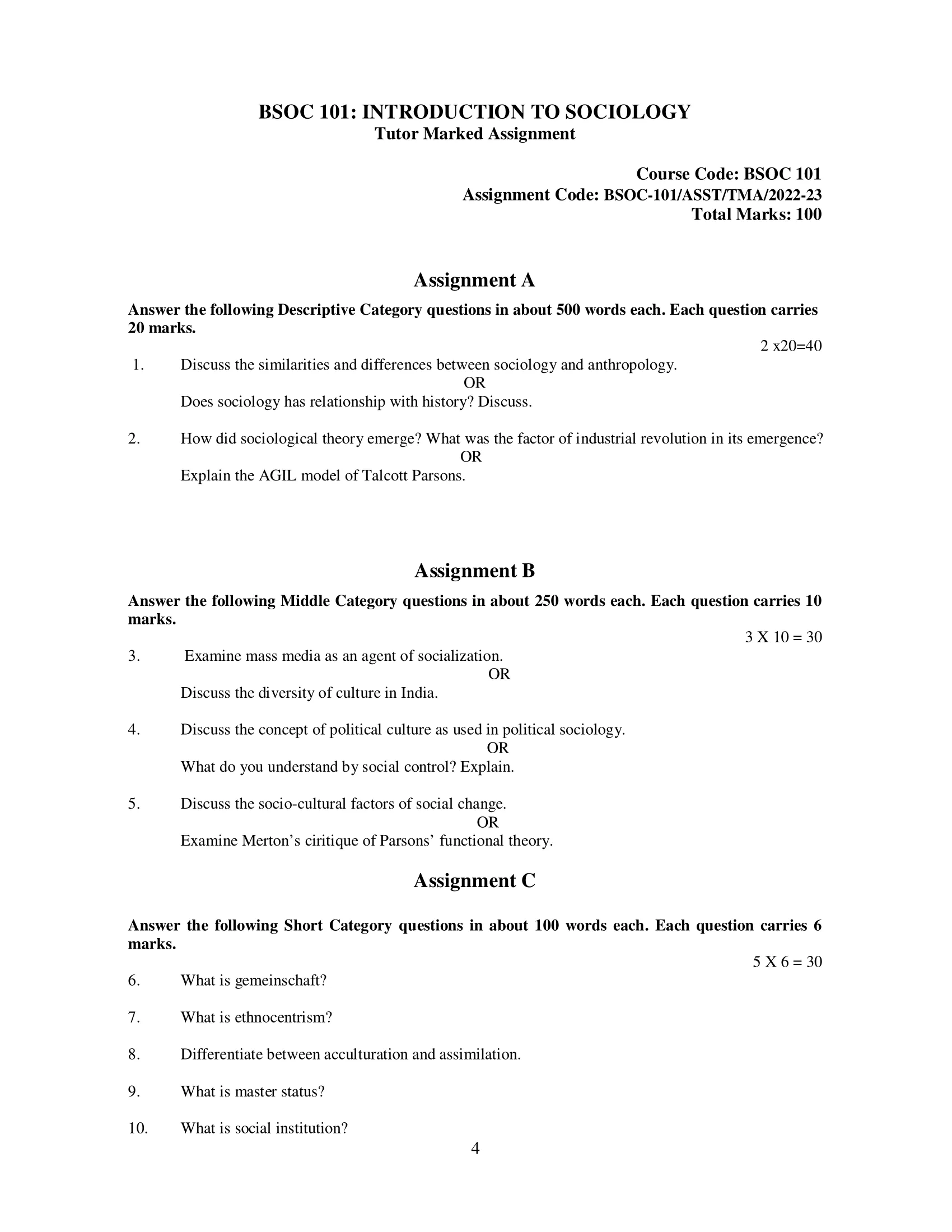Contents
- 1 Assignment A
- 2 Answer the following Descriptive Category questions in about 500 words each. Each question carries 20 marks.
- 3 1. Discuss the similarities and differences between sociology and anthropology.
- 4 Does sociology has relationship with history? Discuss.
- 5 2. How did sociological theory emerge? What was the factor of industrial revolution in its emergence?
- 6 Explain the AGIL model of Talcott Parsons.
- 7 Assignment B
- 8 Answer the following Middle Category questions in about 250 words each. Each question carries 10 marks.
- 9 3. Examine mass media as an agent of socialization.
- 10 Discuss the diversity of culture in India.
- 11 4. Discuss the concept of political culture as used in political sociology.
- 12 What do you understand by social control? Explain.
- 13 5. Discuss the socio-cultural factors of social change.
- 14 Examine Merton’s ciritique of Parsons’ functional theory.
- 15 Assignment C
- 16 Answer the following Short Category questions in about 100 words each. Each question carries 6 marks.
- 17 6. What is gemeinschaft?
- 18 7. What is ethnocentrism?
- 19 8. Differentiate between acculturation and assimilation.
- 20 9. What is master status?
- 21 10. What is social institution?

| Title | BSOC 101 IGNOU BAG Solved Assignment-INTRODUCTION TO SOCIOLOGY |
| University | IGNOU |
| Degree | Bachelor Degree Programme |
| Course Code | BSOC-101 |
| Course Name | INTRODUCTION TO SOCIOLOGY |
| Programme Name | Bachelor of Arts (General) |
| Programme Code | BAG |
| Total Marks | 100 |
| Year | 2022-2023 |
| Language | English |
| Assignment Code | BSOC-101/ASST/TMA/2022-23 |
| Assignment PDF | Click Here |
| Last Date for Submission of Assignment: | For June Examination: 31st April For December Examination: 30th September |

Assignment A
Answer the following Descriptive Category questions in about 500 words each. Each question carries 20 marks.
1. Discuss the similarities and differences between sociology and anthropology.
Ans: Sociology and anthropology are two closely related fields of study that share many similarities, but also have distinct differences. In this essay, I will discuss the similarities and differences between sociology and anthropology.
Similarities:
- Both fields are concerned with the study of human behavior, social relationships, and culture. They aim to understand the ways in which people interact with each other and with the larger social structures that shape their lives.
- Both fields use a variety of research methods, including observation, interviews, surveys, and archival research, to collect data on human behavior and social structures.
- Both fields are interdisciplinary, drawing on theories and methods from a range of disciplines, including history, economics, psychology, and political science.
- Both fields emphasize the importance of cultural relativism, recognizing that different societies have their own unique cultures, values, and norms.
Differences:
- Focus: Sociology is primarily concerned with the study of modern societies, with a focus on social structures, institutions, and social change. Anthropology, on the other hand, has a broader focus, encompassing the study of all human societies, both past and present, with an emphasis on culture, traditions, and practices.
- Methodology: Anthropology tends to rely more on qualitative research methods, such as participant observation, ethnography, and in-depth interviews, to understand the complex social and cultural contexts in which people live. Sociology, on the other hand, often uses quantitative research methods, such as statistical analysis and surveys, to study large populations and make generalizations about social trends and patterns.
- Concepts: Sociology often employs concepts such as social stratification, social class, and power to analyze social structures and patterns of inequality. Anthropology, in contrast, uses concepts such as culture, ritual, and symbolism to understand the meanings and values that shape people’s lives.
- Historical Perspective: Anthropology tends to take a long-term, historical perspective, tracing the development of human societies over time and across different regions. Sociology, on the other hand, tends to focus more on the present, studying the dynamics of contemporary society and the forces that shape social change.
OR
Does sociology has relationship with history? Discuss.
Ans: Yes, sociology has a close relationship with history. In fact, history is one of the key fields that has influenced the development of sociology as a discipline. Sociology and history share a common interest in studying human societies, cultures, and social change. In this essay, I will discuss the relationship between sociology and history.
- Historical Perspective: One of the key ways in which sociology and history are related is through their shared focus on the historical perspective. Sociology recognizes that social structures and patterns of behavior are not fixed and unchanging, but rather are constantly evolving over time. By studying historical trends and patterns of social change, sociologists are able to better understand the ways in which society has developed over time.
- Social Change: Sociology and history also share a common interest in studying social change. Both fields are concerned with understanding the factors that drive social change, and how societies respond to those changes. Sociologists use historical data to analyze long-term trends in social change, while historians examine the specific events and processes that have shaped the development of societies over time.
- Historical Sociology: The field of historical sociology is a subfield of sociology that focuses on the relationship between social structures and historical processes. Historical sociologists use historical data to analyze the ways in which social structures have evolved over time, and how those changes have affected the lives of individuals and groups within society.
- Comparative Analysis: Both sociology and history use comparative analysis to understand social phenomena. Sociologists often compare different societies or social systems to identify patterns and trends, while historians use comparative analysis to examine the similarities and differences between different historical periods or regions.
- Methodology: While sociology and history differ in their methodology, they both use a variety of research methods to collect and analyze data. Sociologists often use quantitative methods such as surveys and statistical analysis, while historians rely more on qualitative methods such as archival research and oral histories. However, both fields recognize the importance of using multiple sources of data to develop a comprehensive understanding of social phenomena.
2. How did sociological theory emerge? What was the factor of industrial revolution in its emergence?
Ans: Sociological theory emerged in the 19th century, in response to the social, economic, and political changes that were taking place as a result of the Industrial Revolution. The Industrial Revolution was a period of rapid technological development and economic growth, which led to significant changes in the organization of work, family life, and social relationships. In this essay, I will discuss how sociological theory emerged and the role of the Industrial Revolution in its emergence.
Sociological theory emerged as a response to the challenges posed by the social changes brought about by the Industrial Revolution. The Industrial Revolution led to the growth of cities, the rise of factory labor, and the development of a new class of industrial capitalists who controlled the means of production. These changes created new social problems and inequalities, and sociological theorists sought to understand and explain them.
The first sociological theorists were known as social philosophers or social theorists, and they were interested in developing a systematic understanding of society and social relationships. One of the key figures in the development of sociological theory was Auguste Comte, who coined the term “sociology” and emphasized the importance of studying social phenomena scientifically. Comte’s work influenced other early sociological theorists, including Herbert Spencer and Emile Durkheim.
Durkheim, in particular, was interested in understanding the ways in which social norms and values shaped individual behavior. He argued that society was more than the sum of its parts, and that social structures and institutions played a key role in shaping human behavior. Durkheim’s work laid the foundation for the functionalist perspective in sociological theory, which emphasizes the importance of social structures and institutions in maintaining social order.
The Industrial Revolution played a significant role in the emergence of sociological theory, as it led to significant changes in the organization of work and the structure of society. The growth of cities and the rise of factory labor created new social problems, including urban poverty, overcrowding, and social dislocation. Sociological theorists sought to understand these problems and to develop theories that could explain them.
The Industrial Revolution also led to the development of a new class of industrial capitalists who controlled the means of production. This led to significant inequalities between the wealthy capitalist class and the working-class population. Sociological theorists sought to understand the causes and consequences of these inequalities, and to develop theories that could explain the dynamics of social class and social stratification.
OR
Explain the AGIL model of Talcott Parsons.
Ans: The AGIL model is a theoretical framework developed by Talcott Parsons, one of the most prominent American sociologists of the 20th century. The model is designed to explain the basic functions of social systems and the ways in which these functions contribute to the stability and survival of society. The acronym AGIL stands for adaptation, goal attainment, integration, and latency. In this essay, I will explain the AGIL model and its key components.
Adaptation refers to the ability of a social system to adapt to changes in its external environment. In order to survive and thrive, social systems must be able to adapt to changing social, economic, and political conditions. Adaptation involves the ability of a system to acquire and distribute resources, to respond to changing demands and challenges, and to coordinate its activities with those of other systems in its environment.
Goal attainment refers to the ability of a social system to set and achieve its goals. Every social system has goals that it seeks to achieve, whether those goals are economic, political, or social in nature. In order to achieve these goals, social systems must be able to mobilize resources, coordinate their activities, and make decisions that are consistent with their overall objectives.
Integration refers to the ways in which social systems are organized and coordinated. In order to achieve their goals and adapt to changing conditions, social systems must be able to coordinate their activities and resources. Integration involves the development of norms, values, and institutions that promote social order and cooperation, as well as the establishment of social roles and hierarchies that help to maintain stability and control.
Latency refers to the ways in which social systems maintain their stability and continuity over time. In order to survive and thrive, social systems must be able to maintain a sense of identity and continuity over time. Latency involves the development of cultural and institutional practices that reinforce social norms and values, as well as the establishment of traditions and rituals that help to maintain social cohesion and stability.
Assignment B
Answer the following Middle Category questions in about 250 words each. Each question carries 10 marks.
Ans: Mass media refers to various forms of communication channels that disseminate information to a large audience. These channels include television, radio, newspapers, magazines, social media, and the internet. Mass media plays an essential role in shaping individuals’ beliefs, attitudes, and behaviors, thereby making it a significant agent of socialization.
Mass media’s influence on socialization starts early in life, as children watch television, read magazines, and use social media platforms. These forms of media provide children with a range of role models and present various values and behaviors that they may internalize. For instance, television programs and movies can promote stereotypes or present diverse individuals and cultures. Similarly, social media platforms can foster the development of social skills and provide a platform for social interaction and communication.
In addition, mass media can help individuals develop their political and civic beliefs and values. News programs, documentaries, and social media platforms provide information and perspectives that shape how individuals perceive and respond to social issues, politics, and other significant events. They can also affect the public’s opinion and attitudes towards institutions, such as the government, corporations, or public figures.
However, mass media can also have negative effects on socialization. For example, it can promote unrealistic beauty standards or present violent behaviors and actions as acceptable. Similarly, media can reinforce gender stereotypes and promote the development of discriminatory attitudes and beliefs.
OR
Discuss the diversity of culture in India.
Ans: India is a land of diversity, with its people, languages, religions, and cultural practices reflecting a rich and vibrant tapestry of traditions. India’s culture is a fusion of various influences, including indigenous practices, religious beliefs, and foreign influences. The country’s diversity is evident in its art, music, dance, clothing, cuisine, and festivals, which vary significantly from region to region.
One of the most prominent aspects of Indian culture is its linguistic diversity. India is home to over 1,600 languages, with Hindi being the official language of the country. Other prominent languages include Bengali, Tamil, Telugu, Kannada, and Marathi, among others. Each language reflects a unique culture, with its literature, music, and artistic traditions.
Religion is another significant aspect of India’s diversity, with Hinduism being the dominant religion. However, India is also home to several other religions, including Islam, Christianity, Sikhism, Buddhism, Jainism, and Zoroastrianism, among others. Each religion has its unique customs, traditions, and festivals, which are an essential part of India’s diverse cultural landscape.
Food is also an integral part of India’s culture, with various regions boasting their unique cuisine. Each region’s cuisine is influenced by its geography, climate, and available resources, resulting in a vast range of dishes and flavors. Some of the most popular Indian dishes include biryani, butter chicken, dosa, idli, and samosas, among others.
India’s diversity is also evident in its art and architecture. The country’s architecture reflects its rich cultural heritage, with structures like the Taj Mahal, Red Fort, and the Khajuraho Temples showcasing India’s past glory. Art forms like Madhubani paintings, Kalamkari, Warli, and Pattachitra are famous for their intricate details and vibrant colors, each unique to their respective regions.
4. Discuss the concept of political culture as used in political sociology.
Ans: Political culture refers to the set of shared beliefs, attitudes, values, and practices that define a society’s political system. It reflects the ways in which people understand and participate in politics, and it is shaped by various factors, including history, tradition, religion, education, and economic development. Political culture is an essential concept in political sociology as it provides a framework for analyzing political behavior and decision-making.
Political culture is significant in understanding how political institutions and structures function in a given society. The way people view their political system, and the attitudes they hold towards it, can shape their level of participation and involvement in political activities. A strong and vibrant political culture that fosters active participation can lead to a more responsive and accountable government.
There are different types of political cultures, including authoritarian, democratic, and participatory. In authoritarian political cultures, power is concentrated in the hands of a small elite, and citizens have limited participation in decision-making processes. In democratic political cultures, citizens are encouraged to participate actively in the political process and hold the government accountable. In participatory political cultures, citizens are encouraged to engage in political decision-making processes directly.
Political culture is also shaped by various factors, including history, tradition, and religion. Historical events, such as wars and revolutions, can shape a society’s political culture by promoting certain values and attitudes towards government and political structures. Similarly, religious beliefs and practices can shape political culture by providing a set of values and principles that guide political behavior.
OR
Ans: Social control refers to the various mechanisms and processes that are used to maintain social order and conformity to social norms and values within a society. It involves the regulation of individual behavior and the prevention of deviance, crime, and other forms of social disruption.
Social control can take many forms, including formal and informal mechanisms. Formal mechanisms of social control include laws, rules, and regulations that are enforced by the state, such as the police, courts, and other legal institutions. Informal mechanisms of social control, on the other hand, refer to the various social norms, values, and beliefs that are enforced by the community, such as peer pressure, social stigma, and the influence of family and friends.
Social control plays an important role in maintaining social order and promoting social cohesion. It helps to regulate individual behavior and prevent social disruption, by setting clear boundaries and expectations for behavior and enforcing them through a variety of mechanisms. It also helps to promote social stability and continuity, by providing a sense of shared identity and purpose, and reinforcing social norms and values.
However, social control can also have negative effects, particularly when it is used to reinforce unjust or discriminatory social structures or to suppress dissent and political opposition. It can also be used to stifle creativity and innovation, and to limit individual freedom and autonomy.
Ans: Social change refers to the process of transformation that occurs in social structures and cultural patterns over time. It can be driven by a variety of factors, including technological innovation, economic development, political movements, and demographic shifts. However, one important set of factors that shape social change are socio-cultural factors. In this essay, I will discuss some of the socio-cultural factors that contribute to social change.
- Cultural values and beliefs: Cultural values and beliefs shape social attitudes, norms, and behaviors. As values and beliefs change over time, they can drive social change in a variety of ways. For example, changes in attitudes towards gender roles, sexual orientation, or religious practices can lead to changes in social norms and expectations, which in turn can affect social behavior and institutions.
- Demographic factors: Demographic factors, such as population growth, migration, and aging, can have significant impacts on social change. Changes in the age structure of a population, for example, can affect economic and political systems, as well as social values and attitudes.
- Technology: Technological innovation can have a profound impact on social change, by altering patterns of production, consumption, and communication. For example, the development of the internet and social media has led to new forms of social interaction and activism, which have in turn contributed to changes in social norms and values.
- Economic development: Economic development can also drive social change by altering patterns of production, consumption, and distribution. As societies become more economically developed, they may experience shifts in social values and priorities, such as greater emphasis on individualism, consumerism, or environmental sustainability.
- Political movements: Political movements can also play a significant role in driving social change, by advocating for new laws, policies, and social norms. For example, civil rights movements, feminist movements, and environmental movements have all contributed to significant social changes in the past century.
OR
Examine Merton’s ciritique of Parsons’ functional theory.
Ans: Talcott Parsons’ functional theory is a grand sociological theory that seeks to explain the role of social institutions in society and how they contribute to social order and stability. According to Parsons, social institutions have four functional imperatives (AGIL), which are necessary for society to function: adaptation, goal attainment, integration, and latency. Parsons’ theory has been widely influential in the field of sociology, but it has also been subject to criticism, particularly by Robert Merton.
Merton was a contemporary of Parsons, and his critique of Parsons’ functional theory was one of the most significant challenges to the theory. Merton argued that Parsons’ functional theory was too abstract and general to be useful in explaining specific social phenomena. He criticized Parsons for focusing too much on the positive functions of social institutions and neglecting the negative consequences that they can have.
Merton also developed the concept of “latent dysfunction,” which refers to unintended negative consequences of social institutions. Merton argued that social institutions can have both manifest and latent functions, and that sociologists need to be aware of both when analyzing social phenomena. He used the example of the American education system, which has the manifest function of educating students, but also has the latent dysfunction of reproducing social inequalities.
Furthermore, Merton argued that Parsons’ functional theory did not adequately account for social change. He suggested that social institutions may not always perform their intended functions, and that this can lead to social change. For example, a social institution that is designed to promote social integration may instead foster social conflict and resistance.
Assignment C
Answer the following Short Category questions in about 100 words each. Each question carries 6 marks.
6. What is gemeinschaft?
Ans: Gemeinschaft is a concept in sociology that refers to a type of social organization characterized by strong social bonds and a sense of community. It is often contrasted with Gesellschaft, which is a type of social organization characterized by more formal, impersonal relationships. Gemeinschaft is typically associated with smaller, rural communities where people have close, personal relationships with one another, and where there is a shared sense of tradition and history. In a gemeinschaft, social relationships are governed by custom, tradition, and mutual trust, rather than by formal rules and regulations.
7. What is ethnocentrism?
Ans: Ethnocentrism is the belief that one’s own culture or ethnic group is superior to others, and the tendency to judge other cultures based on one’s own cultural standards. It often leads to a biased and narrow-minded perspective, which can result in discrimination and prejudice towards people of different cultures. Ethnocentrism can manifest in different ways, such as the belief that one’s own language is superior, the belief that one’s religion is the only true faith, or the belief that one’s own customs and traditions are the only acceptable way of doing things. It can hinder cross-cultural communication, understanding, and cooperation, and can be a significant barrier to building inclusive and diverse communities.
8. Differentiate between acculturation and assimilation.
Ans: Acculturation and assimilation are two concepts that are often used interchangeably, but they have distinct meanings.
Acculturation refers to the process of adapting to a new culture while still retaining some aspects of one’s original culture. In other words, it involves blending elements of one’s own culture with the customs and traditions of the new culture. Acculturation can be a two-way process, where both cultures exchange and adopt new ideas and practices.
Assimilation, on the other hand, involves fully adopting the norms, values, and customs of a new culture and leaving behind the original culture. It implies complete cultural integration and often involves giving up one’s own language, traditions, and identity in order to conform to the dominant culture.
In summary, acculturation allows for cultural exchange and adaptation, while assimilation involves a more one-sided adoption of a new culture.
9. What is master status?
Ans: In sociology, “master status” refers to a status or identity that is considered the most significant or dominant aspect of a person’s social identity, often overshadowing other aspects of their identity.
This status can be determined by a variety of factors, such as a person’s occupation, gender, race, or physical ability. For example, a person’s occupation as a doctor may be considered their master status, which can influence how others perceive and interact with them. Similarly, a person’s race or ethnicity can often be a master status, as it can shape how they are perceived and treated by others.
Master status can have both positive and negative effects on a person’s life. It can provide a sense of identity, belonging, and pride, but it can also lead to stereotypes, discrimination, and unequal treatment.
Ans: A social institution is a complex set of social norms, values, beliefs, and practices that are organized around a specific function or purpose. These institutions serve as frameworks that help individuals navigate their social worlds, and they exist to regulate and control the behavior of people within a society. Examples of social institutions include family, education, religion, government, and the economy. These institutions provide stability and continuity to social life by creating expectations for behavior and providing a sense of belonging to individuals. Social institutions are often deeply ingrained in a culture and are passed down from generation to generation. They play a crucial role in shaping social interactions and relationships and in maintaining social order.
How to Download BSOC-101 Solved Assignment?
You can download it from the www.edukar.in, they have a big database for all the IGNOU solved assignments.
Is the BSOC-101 Solved Assignment Free?
Yes this is absolutely free to download the solved assignment from www.edukar.in
What is the last submission date for BSOC-101 Solved Assignment?
For June Examination: 31st April, For December Examination: 30th October















